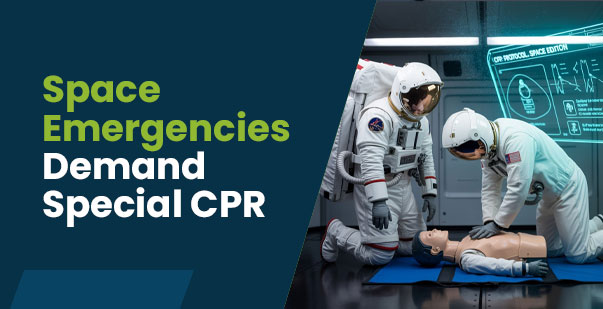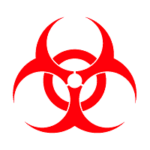Imagine you’re floating in the stillness of space, surrounded by blinking panels and the soft hum of the spacecraft. Suddenly, your crewmate grabs their chest and collapses. There’s no 911 to call. No emergency room to rush to. Just you, a floating body, and a race against time.
This is why Cardiopulmonary Resuscitation (CPR) training is essential for astronauts. In space, even minor malfunctions or medical incidents can turn life-threatening in seconds. While we often picture space as a place for science and exploration, it is, above all, an environment that demands precision, readiness, and survival skills. Among those, CPR takes on a uniquely critical role, modified for a place where gravity doesn’t help you push down on a chest. In this blog, we will explore the vital role of CPR in space missions, the unique challenges astronauts face in zero-gravity environments, and how space agencies like NASA are preparing astronauts to save lives.
Why is CPR in Space Necessary?
While space missions are rigorously planned with an emphasis on safety, emergencies can still happen. Astronauts face health risks not just from the environment but also from the physical and psychological stress of living in space. Cardiovascular issues, trauma, and other medical emergencies are real concerns, even in the meticulously controlled conditions of spacecraft like the International Space Station (ISS).
If an astronaut experiences cardiac arrest or other severe medical conditions, timely intervention is critical. In such scenarios, CPR is one of the first life-saving techniques that could be employed, as help from medical personnel on the ground is hours or even days away.
Additionally, astronauts may experience sudden health issues due to factors like radiation exposure, fluid shifts, bone density loss, and the extended effects of weightlessness on the cardiovascular system. These concerns make learning space mission lifesaving skills for both routine operations and unplanned emergencies.
Interestingly, no astronaut has required CPR in space yet. But that doesn’t mean the risk isn’t real. Space agencies view CPR training as a mission-critical safety protocol, just like spacewalks or fire drills.
What Does CPR Training for Astronauts Include?
Each Crew Medical Officer (CMO), a designated astronaut trained in medical response, undergoes approximately 40 hours of CPR and emergency medicine training over an 18-month pre-mission period. This training is part of NASA’s wider Spaceflight Medical Operations Program. Astronauts train using advanced medical simulation dummies that replicate human anatomy and offer real-time feedback on chest compressions and rescue breaths. These simulations often occur in neutral buoyancy labs or VR-assisted setups that mimic microgravity environments. This helps astronauts understand how their movements and forces change in space. They also:
- Watch medical training videos and animations on zero-gravity emergency procedures
- Perform mock drills in full-space gear
- Learn to communicate with flight surgeons on Earth during medical crises
- Practice hands-only CPR adaptations like the Evetts-Russomano method (a zero-G CPR technique using leg bracing)
Training is not limited to textbook procedures. NASA includes real-time emergency response scenarios, including situations where the rescuer is injured or panicked. The goal is to ensure astronauts don’t freeze in the moment because even a short delay can cost a life when you’re 250 miles above the Earth.
Read More: Heart Disease: Facts and Statistics You Must Know
The Unique Challenges of Performing CPR in Microgravity
In microgravity, the physical laws we are accustomed to on Earth no longer apply. Astronauts float freely in their spacecraft, and everything inside the spacecraft is weightless. This means that conventional CPR, which involves chest compressions and the use of gravity to help return blood to vital organs, cannot be applied in the same way in space.
Several factors complicate CPR in space, including:
1. The Lack of Gravity
On Earth, gravity helps push blood through the body during chest compressions. When you press down on someone’s chest, your weight assists in creating the force needed to circulate blood. In space, however, that simple act turns complex. In microgravity, every action causes an equal and opposite reaction. So instead of compressing a chest, your push might send you drifting backwards, away from the patient. That’s why traditional CPR techniques don’t work in space without modifications.
Astronauts must learn alternative CPR methods that involve anchoring themselves. They might wedge their feet under rails, grip handholds, or even lock their legs around the patient. This stabilizes their body so force can be directed where it’s needed. One commonly taught method is the Evetts-Russomano technique, where the rescuer uses their legs to anchor around the patient’s torso while performing compressions with both hands. It’s physically demanding and mentally challenging, but it’s currently one of the best solutions available.
2. Movement in Microgravity
On Earth, staying grounded is automatic. In space, it’s a constant battle. During CPR, the astronaut performing compressions must stay perfectly aligned and stable, or the technique won’t work. To maintain position, astronauts use:
- Handrails and foot restraints built into spacecraft modules
- Hook-and-loop (Velcro-like) straps to secure limbs
- Tethers or body harnesses to lock themselves to walls or the patient
Sometimes, astronauts use their own legs as a bracing tool, wrapping around the victim to create a human anchor system. These adaptive strategies ensure that motion is absorbed and focused into compressions rather than wasted by floating.
3. Limited Medical Equipment
On Earth, CPR is just the start of a medical response. Paramedics arrive with defibrillators, oxygen tanks, medications, and IV fluids. In space, those tools are restricted by weight, space, and power limitations. However, spacecraft like the International Space Station (ISS) do have a basic Crew Medical Kit (CMK). This typically includes:
- An Automated External Defibrillator (AED)
- First aid supplies (bandages, antiseptics, gloves)
- Basic medications (pain relievers, antihistamines, antibiotics)
- Airway support tools (bag-valve masks, oxygen masks)
- IV supplies and fluids
- Diagnostic tools (thermometers, pulse oximeters, blood pressure cuffs)
In a cardiac emergency, the Crew Medical Officer communicates in real-time with physicians on Earth. But the first 10 minutes are entirely up to the astronauts themselves. That’s why CPR training and preparedness are so critical.
4. Physical Stress on Astronauts
Performing CPR on Earth requires a significant amount of physical effort, particularly when chest compressions need to be deep and fast. In microgravity, the effort required is even more strenuous due to the lack of gravity to assist the process. Astronauts also need to be mindful of their physical limitations, as the stress of performing CPR may affect their ability to continue the task or even impact their health.
In a video posted on social media, Astronaut Samantha Cristoforetti showed the physical challenges of performing CPR in microgravity, stating: “You have to find a way to push off against [a surface]” while performing chest compressions. This necessity arises because the lack of gravity prevents stable positioning, which makes the process physically demanding and requires creative use of surfaces for leverage
Components of Astronaut Training for Zero-Gravity CPR
Given the above-mentioned challenges, proper space training is vital to ensure astronaut medical preparedness specific to the zero-gravity environment. With the training, it can be ensured that astronauts will know exactly what to do and can act swiftly. The training involves both theoretical knowledge and hands-on practice:
- Classroom Training
Astronauts begin their CPR training with classroom instruction. Here, they learn the standard CPR protocols that are employed on Earth, including the correct techniques for chest compressions, rescue breathing, and using automated external defibrillators (AEDs). They also learn the unique medical procedures for space missions, including the need for additional precautions in a zero-gravity environment.
- Simulated Microgravity Environments
To effectively train astronauts, NASA astronaut CPR training and other space agencies use simulated microgravity environments. The common method in the training is the Neutral Buoyancy Laboratory (NBL), a giant swimming pool at the Johnson Space Center in Houston, Texas. Here, astronauts practice CPR on a “patient” while floating in the water, mimicking the lack of gravity they will experience in space. This allows astronauts to practice positioning themselves and applying chest compressions in a floating environment.
- Simulated Spacecraft Environments
Astronauts undergo intensive CPR training inside mock spacecraft like those in NASA’s Spacecraft Training Facility (STF) or the Neutral Buoyancy Laboratory (NBL). These environments are equipped with exact replicas of space station interiors, complete with foot loops, handrails, seat harnesses, and medical kits.
For example, astronauts rehearse CPR using a floating mannequin inside an ISS module mockup. One common drill involves locking their feet into Velcro foot restraints, gripping nearby rails for leverage, and positioning the patient in a “supine float” to begin compressions. They learn to perform the hand-anchored or straddling technique, applying pressure while bracing themselves to avoid drifting away. These sessions build muscle memory and spatial awareness so that astronauts can respond automatically when a real emergency strikes.
- Telemedicine and Communication with Earth
The core element of space station emergency protocols is the ability to communicate with Earth-based medical experts during an emergency. Real-time voice and video links allow doctors to observe vital signs, coach through procedures, and give live feedback during CPR or other interventions.
Astronauts train to operate these systems efficiently. They use tablets or onboard consoles to stream patient data and relay verbal reports. They are taught to speak calmly, share vital signs clearly, and follow guidance even under pressure.
- Psychological Training
Performing CPR is a stressful, high-pressure situation. Astronauts must be prepared for the psychological strain of an emergency, especially when lives are at risk. Therefore, mental health training is incorporated into the CPR training process to help astronauts manage the stress of medical emergencies. To stay calm, astronauts learn:
- Controlled breathing techniques to manage heart rate and reduce anxiety
- Guided meditation and visualization to rehearse emergencies mentally
- Decision-making under stress exercises, often run in simulators with sudden “emergency” scenarios
- Peer support protocols, where crewmates debrief together and recognize emotional fatigue
NASA also provides access to mental health professionals during missions. These sessions help astronauts process their experiences and maintain emotional balance over long durations.
Read More: Heart Disease: Facts and Statistics You Must Know
The Evolution of CPR Training for Space Missions
As space exploration evolves, the zero-gravity CPR techniques to train astronauts continue to improve. Innovations in virtual reality (VR) and artificial intelligence (AI) have the potential to enhance training programs further.
1. Virtual Reality (VR) Training
NASA uses VR-enabled simulation programs like the Crew Health Care System Training Tool (CHeCS) to provide astronauts with realistic, immersive CPR practice. These virtual modules replicate zero-gravity environments where crew members can interact with holographic patients in medical emergencies.
Wearing a VR headset and hand controllers, astronauts find themselves inside a simulated ISS module, floating beside a virtual crewmate in distress. The experience feels like “playing a space video game,” but every action, such as compressions, airway checks, or following on-screen prompts, could one day save a life.
With VR, astronauts can repeat scenarios dozens of times, adjusting their reaction speed, technique, and confidence. Emergencies like sudden cardiac arrest or trauma from space debris impact can be simulated. Each scenario ends with a debrief to help the trainee reflect and improve. This technology allows consistent practice without needing physical access to mockups or equipment,
2. Artificial Intelligence and Robotics
AI-powered performance trackers analyze compression depth, rhythm, and positioning, offering real-time corrective feedback during training. This helps astronauts refine their techniques with precision.
NASA also incorporates robotic systems like the Laerdal Resusci Anne Simulator, a high-fidelity manikin capable of simulating realistic human responses, such as changes in skin color, pulse, and breathing. This robot provides an interactive, reactive training partner, allowing astronauts to practice CPR with dynamic feedback. For instance, the robot can simulate a sudden arrhythmia mid-session, requiring the astronaut to adjust strategy on the fly.
In future missions, AI may also guide astronauts during real emergencies by offering step-by-step instructions via headset, functioning as a virtual assistant when ground communication is delayed, especially required during deep-space operations like Mars missions.
Preparing for the Unknown: Space Missions and Medical Readiness
As humanity’s presence in space grows, the need for effective medical training, including zero-gravity CPR techniques, will become even more essential. The future of space exploration is shifting towards missions that involve deep space travel, where medical resources and support from Earth will be even more limited. This makes it imperative for astronauts to be even more self-sufficient and capable of handling emergencies independently.
Space agencies are already investing in developing more advanced medical systems, including robotic surgeries and telemedicine technologies, to support astronauts during such missions. With the right CPR training, tools, and support systems, astronauts will be better prepared to act quickly and save lives in the most extreme conditions imaginable. In space or on Earth, every second matters during an emergency, and knowing CPR might be the difference between life and loss in the final frontier.
Frequently Asked Questions (FAQs)
Can you do CPR in zero gravity?
Yes, CPR can be performed in zero gravity, but it presents challenges due to the lack of gravity to help with compressions. Astronauts use specialized techniques, such as securing the patient to a surface, to apply chest compressions effectively. They also rely on the resistance of their body to provide enough force, as opposed to gravity helping to create pressure on the chest.
How are astronauts trained for zero gravity?
Astronauts undergo extensive training for zero gravity through a combination of classroom learning and practical exercises. They participate in parabolic flights (also called “vomit comets”) that simulate microgravity for short durations, allowing astronauts to practice various tasks in weightlessness. Training also includes virtual reality simulations and mock spacewalks to enhance coordination. Additionally, astronauts learn to adapt their movements and use specialized equipment designed to function in space, preparing them for real-life scenarios aboard spacecraft or space stations.
Does CPR work in space?
Performing CPR in space is difficult due to the lack of gravity, but specialized equipment, such as portable chest compression devices, has been developed to perform automated compressions in space. While traditional CPR techniques are less effective in space, these innovations, alongside remote medical guidance, help increase the chances of successful resuscitation in zero gravity.
Where not to do CPR?
CPR should not be performed when it could cause harm or is unnecessary. For instance, if the person has a pulse or is breathing, CPR should be avoided. It should not be attempted on someone with severe head or neck injuries unless trained to do so, as chest compressions could worsen the injury. Additionally, CPR is not suitable for people in extremely hazardous environments, like underwater, without proper equipment, or when a person has been exposed to electrical hazards until safety is confirmed.






